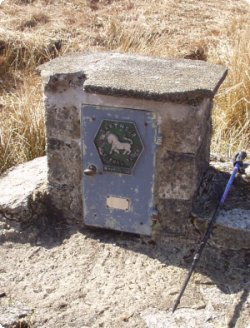Letterboxing Glossary: C
- cacheboxing
-
To participate in cacheboxing, you must find a geocache (either intentionally or accidentally) and select a trinket to use as a makeshift stamp. Der Mad Stamper can be thanked for this ingenious idea on how to never leave a box—any kind of box—empty-handed.
- cached clue
-
Many letterboxes on Atlas Quest actually have their clues hosted somewhere else (LbNA being the most common). However, AQ will still periodically scan the clue from the remote website to check that the URL is still good, index the words in the clue so the clue can be searched if needed and so forth. A version of the clue is saved locally and it’s called a cached clue. It may be out of date since the clues are only checked about once per month, but if the remote website is down or otherwise inaccessible, you can still see a copy of the clue as AQ has saved it.
- cairn
-
Cairns are piles of rock, usually used to mark the direction of a trail. They are especially common over rock or boulder fields where the trail is hard to follow, but they can be found anywhere where there are rocks to pile.

- cardinal points
-
The four principle points on a compass: North, south, east and west.
- catching feature
-
Usually something that, when reached, tells you something about your location. For instance, a letterboxing clue that says to look for a tree on the right, but if you’ve reached a footbridge, you’ve gone too far. The footbridge, in this case, it a ‘catching feature’, and allows you to determine that you’ve gone too far. Rivers and trails make excellent catching features for compass work.
- cat’s eye ink pad
-
A popular type of ink pad with letterboxers due to its compact size and sharp point for detailed inking projects. See image at the right for an example of a cat’s eye ink pad. The tutorial Stamping With Style has lots of ideas on how you might use them.

- cattywhompus
-
Askew or awry. For example, “I found one of my boxes today with the lid screwed on all cattywhompus.”
- chalk ink
-
Chalk ink pads share the resilience of pigment inks, yet they stamp and blend like dye inks on most absorbent surfaces. Permanent when heat set, they resist smearing, bleeding or fading even when air dried. While the manufacturer makes it sound like a completely new super-ink, rumor has it that chalk ink is a reformulated pigment-based ink. Which doesn’t mean it’s the same as pigment-based ink pads, but they will share a lot of the same texture and properties as pigment-based ink pads.
- challenge points
-
You earn a challenge point if you find or attempt a box whose findability is listed as challenging. The owner of a box often cannot check up on their boxes often, so there is often a good probability that the box is missing, but we want to encourage everyone to look for them anyhow and either confirm that box is missing or verify that it is, indeed, still alive and well.
Whether you succeed in finding the box or not doesn’t matter—you get a point for making an effort at hunting down these difficult and elusive boxes and recording the your results. As the points accumulate, the challenge icon by your trailname becomes increasingly more valuable starting with a single silver coin (for the first 5 challenge points earned) to a safe overflowing with cash (if you collect 500+ points).







- check dam
-
Check dams, also called check steps, are usually made of wood or large rocks, and are used on badly eroded trails to stop erosion. They typically look like a step, and a series of them will look much like a staircase. Water will still run down the trail, but check dams will catch sediment and help restore the trail to its former glory.

- checkpoint
-
A conspicuous feature on the terrain used to check one’s progress toward a destination.
- cheese racing
-
An exciting and sometimes dangerous new sport (see photo of wassamatta_u to the right) many letterboxers enjoy that involves throwing a slice of processed cheese (without removing the plastic wrapping) onto a lit BBQ. For more information, check out the official Cheese Racing website. Please note that some letterboxers feel cheese racing constitutes cruel and unusual punishment towards processed cheese and should be illegal.

- chess-boxing
-
Yes, it’s a real thing!
- clitter
- clue blind
-
Not being able to see the landmarks described in the clue.
- ColorBox
-
A popular brand of ink pads that many letterboxers use.
- commando, going
-
The term “going commando” has been adopted by some letterboxers to refer to a letterbox with no plastic baggies protecting the contents. Lock-n-Locks, most notably, are legendary for their ability to repel water. However, a baggie that gets caught in the seal can let water get in, thus removal of the baggie and going commando.
- compass
-
A device (or possibly an app on your smartphone) used to determine directions, frequently used by letterboxers to find a letterbox. Also see orienteering compass. To learn more about compasses and how to use them, please read the Compassing 101 tutorial.

- confiscated letterbox
-
A letterbox planted without permission that has been removed by the person or organization that owns the land where the letterbox was illegally planted. The NPS is legendary for confiscating letterboxes on their land, but any letterbox planted without permission can suffer a similar fate.
- contour line
-
An imaginary line over terrain where all points of the line are the same elevation above (or below!) sea level. Used extensively on topo maps.
- cooties
-
A type of letterbox where one tries to sneak around hiding a stamp (and often times optional logbook) on another person—perhaps in an open backpack or jacket pocket. Once you ‘catch a cootie’, you stamp in and try to pawn it off onto another unsuspecting letterboxer. Cooties are often signed into with the stamp of your thumb or fingers that you draw on to embellish instead of the traditional signature stamp, although many people prefer to use their signature stamp instead. Cooties aren’t in an enclosed container—they need space to move and breath, and the better for stealth. For more cootie talk, visit our Cooties board. Fleas are an offshoot of cooties that allow you to put them in regular boxes as if they were hitchhikers and stamp in with your signature stamp rather than use the thumbprint signature.
- cootie catcher
-
An open and unattended backpack or bag often collects quite a large number of cooties—and thus they are called cootie catchers. One bag at a Stone Mountain gathering collected a whopping 20-odd cooties!
- Cranmere Pool
-
The world’s first letterbox was located in 1854, in a small inaccessible area of Dartmoor known as Cranmere Pool. Do not be fooled by the name—there is no pool of water here. The last sighting of an actual pool was in the early 1800s, but the ground in the area is still very wet and soggy!

- cuckoo clue
-
A clue without a home. The clue is hidden in another letterbox (similar to clues for a bonus boxes), but the letterboxer that finds the clue is expected to move the clue to another nearby letterbox. The cuckoo clue typically contains directions to limit how far the clue should travel to find a new home.
- culvert
-
A drainage structure that passes beneath a trail to allow the flow of water from one side of the trail to the other. Often built into turnpikes.

- custom-made stamp
-
Somewhere between a hand-carved stamp and a store-bought stamp. A custom-made stamp has an original, unique image (and not mass-produced like the ones typically found in stores) but is not crafted by hand like a hand-carved stamp.